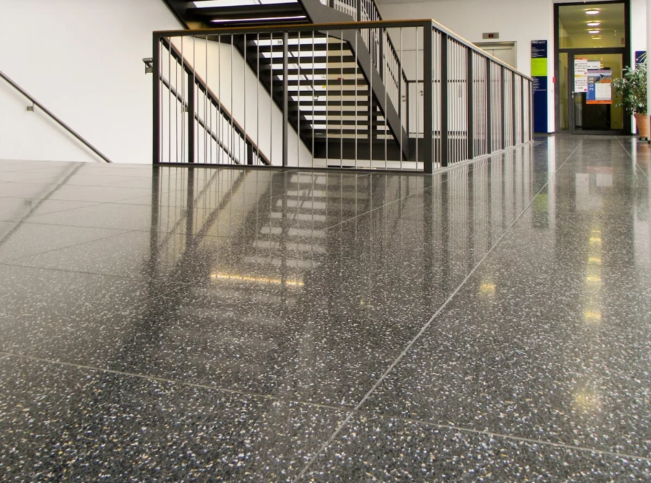
In the realm of interior design, the resurgence of terrazzo floor tiles is nothing short of a renaissance. Revered for its timeless charm, terrazzo has undergone a remarkable revival, reinventing spaces and reshaping contemporary aesthetics. With its origins dating back centuries, this composite material has gracefully transcended time, proving its enduring allure in modern design.
A Historic Resurgence: Rediscovering Terrazzo’s Legacy
Terrazzo, derived from the Italian word “terrazza,” meaning terrace, finds its roots in ancient mosaic techniques. Initially, artisans created terrazzo by embedding marble chips into clay and then polishing the surface with stone fragments and goat’s milk. This age-old practice has evolved into the modern-day terrazzo we admire, composed of marble, quartz, glass, or other aggregates bound with cement or epoxy.
During the mid-20th century, terrazzo became emblematic of luxury in architecture, adorning the floors of palaces, hotels, and public buildings. However, its popularity waned as design preferences shifted towards sleeker, minimalist styles. Now, in a renaissance of design appreciation, terrazzo is experiencing a reawakening, captivating interior enthusiasts and designers alike with its unmatched versatility and aesthetic appeal.
Revitalizing Spaces: Terrazzo’s Contemporary Impact
The resurgence of terrazzo in interior design is multifaceted. Its adaptability allows for a diverse range of applications, transforming spaces from residential to commercial with effortless grace. The infusion of modern technology has expanded the spectrum of colors, shapes, and patterns achievable with terrazzo, empowering designers to unleash their creativity and redefine interior aesthetics.
One of the most captivating aspects of terrazzo is its ability to evoke a sense of refined elegance while maintaining a contemporary edge. Its speckled appearance, crafted from diverse aggregates, creates a visual tapestry that adds depth and character to any room. Whether used in kitchens, bathrooms, or living areas, terrazzo tiles infuse spaces with an understated opulence that resonates with both classic and modern sensibilities.
The Allure of Timelessness: Terrazzo’s Enduring Charm
Terrazzo’s enduring charm lies in its timelessness. Its ability to seamlessly blend with various design styles – from minimalist to maximalist – makes it a versatile choice for diverse interior concepts. Its durability and resistance to wear ensure that terrazzo remains a functional and long-lasting flooring option, surpassing fleeting trends and standing the test of time.
Moreover, terrazzo’s eco-friendly nature contributes to its growing popularity. Utilizing recycled materials in its composition aligns with sustainable design practices, appealing to conscientious homeowners and businesses seeking environmentally responsible solutions without compromising on aesthetics.
Designing with Terrazzo: The Art of Expression
The resurgence of terrazzo has elevated interior design by offering a canvas for expression. Designers and homeowners delight in the creative freedom that terrazzo provides, allowing for bespoke patterns, color combinations, and textures. From subtle, monochromatic schemes to bold, eye-catching designs, terrazzo enables the manifestation of personal style, enhancing spaces with a distinctive allure.
Its adaptability extends beyond floor tiles, finding its way into countertops, backsplashes, and even furniture. This versatility amplifies the cohesiveness of design elements within a space, fostering a harmonious ambiance that exudes sophistication and individuality.
Terrazzo’s Influence on Ambiance and Perception
The impact of terrazzo on the ambiance of a space is profound. Its inherent ability to reflect light and create a sense of movement within its surface adds depth and dynamism to rooms, elevating them from mundane to extraordinary. The speckled patterns and unique textures of terrazzo foster an environment of visual intrigue and tactile appeal, inviting inhabitants and visitors alike to appreciate its artistry.
Furthermore, the choice of terrazzo isn’t just about aesthetics; it’s about cultivating an atmosphere of sophistication and timelessness. Spaces adorned with terrazzo exude a sense of refinement, invoking a feeling of luxury while remaining approachable and welcoming—a rare balance achieved by few materials.
The Future of Terrazzo: Innovations and Evolutions
As design trends evolve, so does the world of terrazzo. Innovations in manufacturing techniques continue to push the boundaries, introducing new possibilities for customization and application. Digital printing technologies have enabled hyper-realistic terrazzo imitations, providing cost-effective alternatives while retaining the essence of this historic material.
Furthermore, the integration of smart design and sustainability practices ensures that terrazzo remains a frontrunner in the quest for eco-conscious materials. Continued experimentation with eco-friendly binders and recycled aggregates contributes to a more sustainable future for terrazzo, solidifying its position as a design staple in the years to come.
In Conclusion
Terrazzo floor tiles have resurfaced as a design icon, redefining interior aesthetics with their classic elegance and modern adaptability. Their resurgence epitomizes a perfect fusion of tradition and innovation, offering a timeless allure that transcends design eras. With its versatility, sustainability, and inherent beauty, terrazzo continues to captivate, inspire, and reinvent spaces, leaving an indelible mark on the world of interior design. As we embrace classic elegance, terrazzo stands as a testament to the enduring appeal of materials that transcend time.
